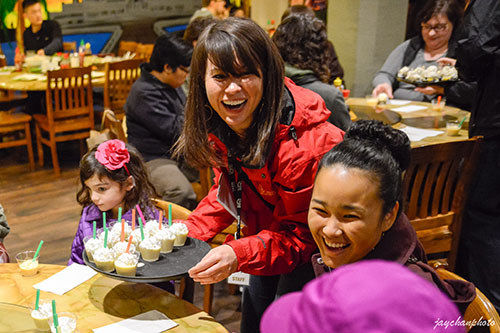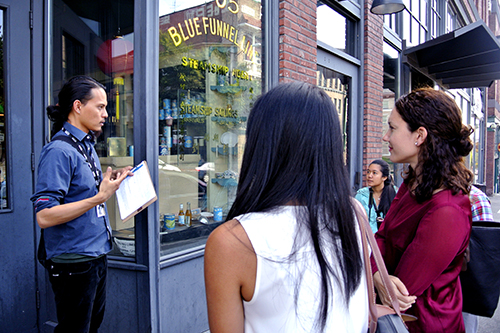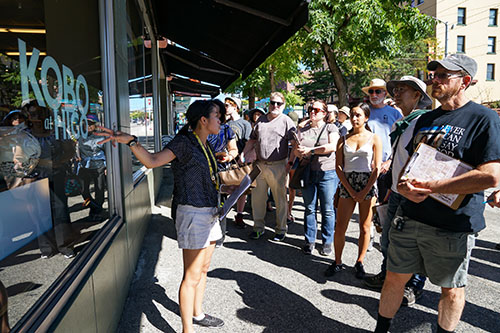Grant Spotlight | August 30, 2018
Share This“The Chinatown-International District has always been the starting place and continues to be the cultural anchor for the region’s Asian Pacific American communities.” –Cassie Chinn, Deputy Executive Director, Wing Luke Museum of the Asian Pacific American Experience

The Wing Luke Museum of the Asian Pacific American Experience, known as “The Wing,” is located in the Chinatown-International District, one of the oldest neighborhoods in Seattle. From Chinatown to historic Japantown, and most recently, Little Saigon, the C-ID holds rich history and cultural significance.
Cassie Chinn, Deputy Executive Director of The Wing, is fourth-generation Chinese American—her grandfather founded a cab company in Chinatown. For Chinn and many Asian Pacific Americans in the Seattle region, the C-ID is a place they call home.
Despite its vibrancy, the C-ID is also one of Seattle’s lowest-income neighborhoods. The community faces many challenges, including gentrification pressures, public works projects, proximity to large sports stadiums, a three-year-long streetcar construction, and a freeway that bisects the neighborhood. “We’re very fragile,” Chinn explained.
Over 30 years ago, community leader Vi Mar launched a tour program called Chinatown Discovery Tours, which operated throughout the C-ID. Upon retirement, she gifted the tour program to The Wing.
In order to help lift up its diverse community, The Wing developed a plan to revitalize its tours. In 2013, the museum applied and received a grant from IMLS to fund a two-year project to enable community members to share their stories, empower local family-run businesses and organizations, and promote the historic and cultural value of the C-ID.
Through the grant, the museum sought to add seasonal tasting tours and integrate community members through storytelling and oral histories, as well as make the most of the partnership that the museum had developed with the Bruce Lee Foundation.
“The project grew out of wanting to both lift up the incredible community and cultural assets that we have, while also doing something proactively in the face of our challenges,” Chinn said. “This was an opportunity to strengthen our community as our neighborhood continues to move forward.”
Building Relationships and Strengthening Partnerships through Dialogue

In order to incorporate community members’ voices and stories, The Wing collaborated with a group of core advisors who helped determine the main messages and the content of the tours. They also helped evaluate the museum’s current programs, identify new stories, and connect them with community members.
“At the core of this was the commitment to building long-term relationships,” said Chinn. The first step was to partner with families who owned the businesses, integrating them into the tours and allowing them to share their personal stories with visitors. If community members were unable to be present, tour guides would gather and share the stories on their behalf. By establishing connections between the families and tour participants, the museum hoped to engage new customers and encourage them to return.
While experience was helpful, having a deep interest in the C-ID was the most important requirement for being a tour guide. “Our number one qualification is that people have a passion for our neighborhood,” said Chinn. As volunteers and guides became more involved with their sites, they learned how to bring out community members’ stories and engage in effective dialogue.
Program Success and Legacy
Since its inception, the project has laid a strong foundation for the museum’s growth, allowing it to increase the capacity of its organization to support new business streams and to improve internal operations.
The project also enabled visitors to experience the C-ID in new, positive ways. The Wing “became more attentive to how people were sharing their experiences” about the C-ID, Chinn said. As online engagement with the tour program grew, it had a “positive ripple effect with the way people described the neighborhood as well.”

The Wing was now also able to continue its tour program year-round. From the seasonal food experiences to a partnership with the National Park Service to create a Japanese American Remembrance Trail, the museum has continued its neighborhood revitalization efforts, remaining relevant in the face of current issues and events.
“Our neighborhood is still facing strong pressures that lead to displacement and gentrification,” said Chinn. “Those issues have not gone away, but [The Wing] has great tools and resources that we can use so that we can continue to lift up our historic and long-time community-based businesses and organizations in our neighborhood.”
For the residents and community members of the C-ID, the museum has served as a place of importance, preserving cultural stories and supporting local businesses and organizations. Through this role, The Wing is, and will continue to be, an anchor for the Chinatown-International District community.
Editor’s Note: Beth Takekawa, the Executive Director at the Wing Luke Museum, also serves as an advisor on the Institute of Museum and Library Services Board.
About the Project
Grant Project Name: Our Asian American Hometown –Anchoring Community Vitality through Culture
Grant Log Number: MA-20-13-0076-13
Year Awarded: 2013
Recipient: Wing Luke Museum of the Asian Pacific American Experience
Project Contact:
Cassie Chinn
Deputy Executive Director at the Wing Luke Museum
cchinn@wingluke.org
206-623-5124 x131
Website: http://www.wingluke.org/
